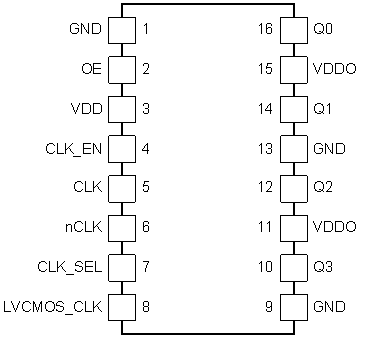SNAS642A June 2014 – July 2014 LMK00804B
PRODUCTION DATA.
- 1 Features
- 2 Applications
- 3 Description
- 4 Simplified Schematic
- 5 Device Comparison Table
- 6 Pin Configuration and Functions
-
7 Specifications
- 7.1 Pin Characteristics
- 7.2 Absolute Maximum Ratings
- 7.3 Handling Ratings
- 7.4 Recommended Operating Conditions
- 7.5 Thermal Information
- 7.6 Power Supply Characteristics
- 7.7 LVCMOS / LVTTL DC Characteristics
- 7.8 Differential Input DC Characteristics
- 7.9 Electrical Characteristics (VDDO = 3.3 V ± 5%)
- 7.10 Electrical Characteristics (VDDO = 2.5 V ± 5%)
- 7.11 Electrical Characteristics (VDDO = 1.8 V ± 0.15 V)
- 7.12 Electrical Characteristics (VDDO = 1.5 V ± 5%)
- 7.13 Typical Characteristics
- 8 Parameter Measurement Information
- 9 Detailed Description
- 10Applications and Implementation
- 11Power Supply Recommendations
- 12Layout
- 13Device and Documentation Support
- 14Mechanical, Packaging, and Orderable Information
6 Pin Configuration and Functions
16 Pin
PW Package
Top View

Pin Functions
| TERMINAL | TYPE(1) | DESCRIPTION | |
|---|---|---|---|
| NAME | NUMBER | ||
| GND | 1, 9, 13 | G | Power supply ground |
| OE | 2 | I, RPU | Output enable input. 0 = Outputs in Hi-Z state 1 = Outputs in active state |
| VDD | 3 | P | Power supply terminal |
| CLK_EN | 4 | I, RPU | Synchronous clock enable input. 0 = Outputs are forced to logic low state 1 = Outputs are enabled with LVCMOS/LVTT levels |
| CLK | 5 | I, RPD | Non-inverting differential clock input 0. |
| nCLK | 6 | I, RPD/RPU | Inverting differential clock input 0. Internally biased to VDD/2 when left floating |
| CLK_SEL | 7 | I, RPU | Clock select input. 0 = Select LVCMOS_CLK 1 = Select CLK, nCLK |
| LVCMOS_CLK | 8 | I, RPD | Single-ended clock input. Accepts LVCMOS/LVTTL levels. |
| Q3, Q2, Q1, Q0 | 10, 12, 14, 16 | O | Single-ended clock outputs with LVCMOS/LVTTL levels, 7Ω output impedance |
| VDDO | 11, 15 | P | Output supply terminals |
(1) G = Ground, I = Input, O = Output, P = Power, RPU = 51 kΩ pullup, RPD = 51 kΩ pulldown.